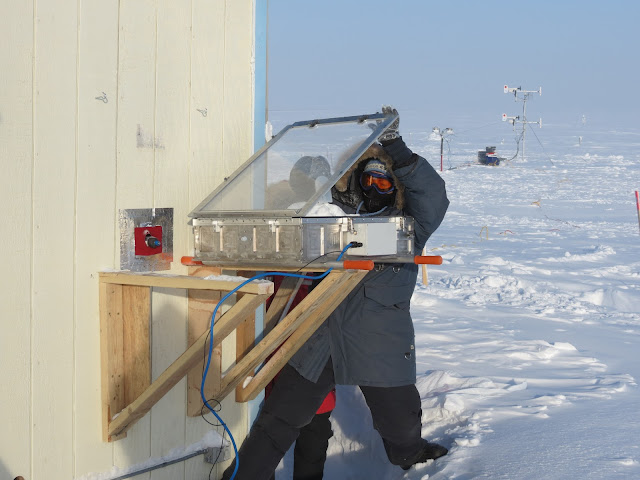Using an outdoor snow chamber, we observed the surface snow above first-year sea ice and tundra to be an efficient source of bromine. Chemical reactions within the snow grains produced molecular bromine under sunlit conditions. The surface snow samples were characterized by bromide, originally from sea water, and acids from the influence of Arctic haze, a urban-like smog produced from the transport of atmospheric pollutants from the mid-latitudes. Reaction with ozone in the air between the snow crystals dramatically increased the amount of molecular bromine produced, which is then released to the atmosphere via wind pumping. Indeed, when using our Purdue University Airborne Laboratory for Atmospheric Research (ALAR), a small aircraft, for spatially-distributed measurements of bromine monoxide, we found it to be located directly above snow over first-year sea ice and tundra, consistent with the snow chamber experiments.
The frozen surfaces in the Arctic are key to this unique natural chemistry that is being perturbed by the rapid loss and transformation of sea ice in the Arctic. Professor Jon Abbatt wrote a News & Views article in Nature Geoscience that gives further context to this work. See below for links!
Link: http://dx.doi.org/10.1038/ngeo1779
News & Views article: http://dx.doi.org/10.1038/ngeo1805
 |
|
Dr. Kerri Pratt, NSF Postdoctoral Fellow in Polar Regions
Research in Prof. Paul Shepson's lab, conducts a snow chamber experiment at -44ºF windchill near Barrow,
Alaska. (Photo credit: Paul Shepson)
|
Dr. Kerri Pratt - National Science Foundation Postdoctoral Fellow in Polar Regions Research, Department of Chemistry, Purdue University
Kyle Custard - Purdue University Chemistry Ph.D. Student
Prof. Paul Shepson - Purdue University Professor of Chemistry, Founder of Purdue Climate Change Research Center
Dr. Tom Douglas - Research Chemist, U.S. Army Cold Regions Research and Engineering Laboratory (Fairbanks, Alaska)
Dr. Denis Pöhler - Research Assistant, Institute of Environmental Physics, University of Heidelberg
Stephan General - University of Heidelberg Physics Ph.D. Student
Johannes Zielcke - University of Heidelberg Physics Ph.D. Student
Prof. Bill Simpson - University of Alaska Fairbanks Professor of Chemistry
Prof. Ulrich Platt - Professor, Institute of Environmental Physics, University of Heidelberg
David Tanner - Research Assistant, Department of Earth and Atmospheric Sciences, Georgia Institute of Technology
Prof. Greg Huey - Professor of Earth and Atmospheric Sciences, Georgia Institute of Technology
Mark Carlsen - Instrumentation Specialist, Jonathan Amy Facility for Chemical Instrumentation, Department of Chemistry, Purdue University
Brian Stirm - Air Operations Technical Specialist, Department of Aviation Technology, Purdue University
Thank you to Son Nghiem (NASA JPL) for helping organize BROMEX, Randy Replogle (Purdue) for building the snow chamber, UMIAQ and CH2M Hill Polar Services for field logistical assistance, Obie Cambaliza and Dana Caulton (Purdue) for aircraft attitude data, Matt Sturm (CRREL) for chamber design advice, Wes Halfacre (Purdue) for ozone monitor calibration, Eric Boone (Purdue) for aerosol data analysis, and Ross Lieb-Lappen (Dartmouth) for field discussions. Thank you also to all of our fantastic BROMEX collaborators that made this field campaign a huge success!
No comments:
Post a Comment